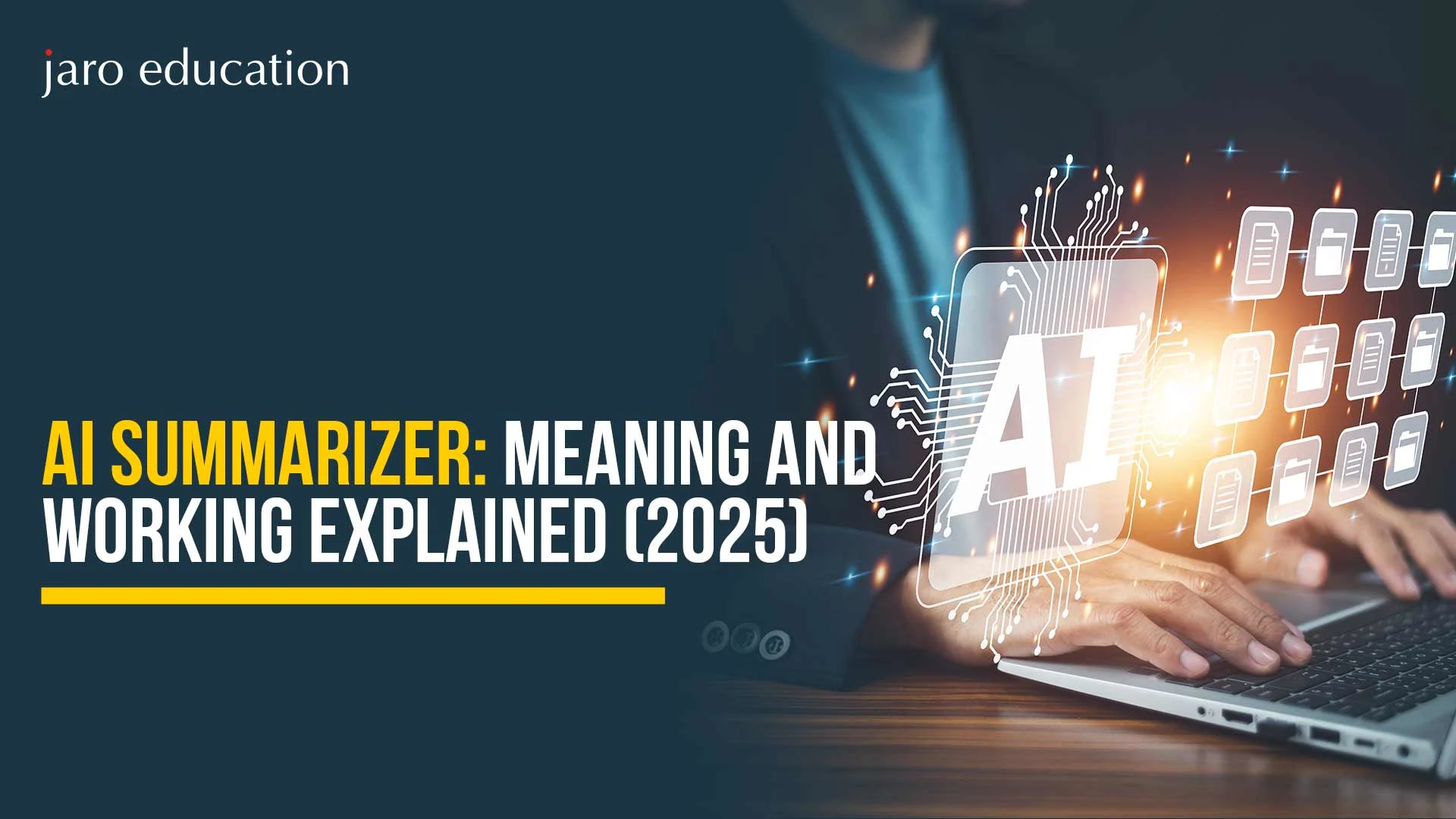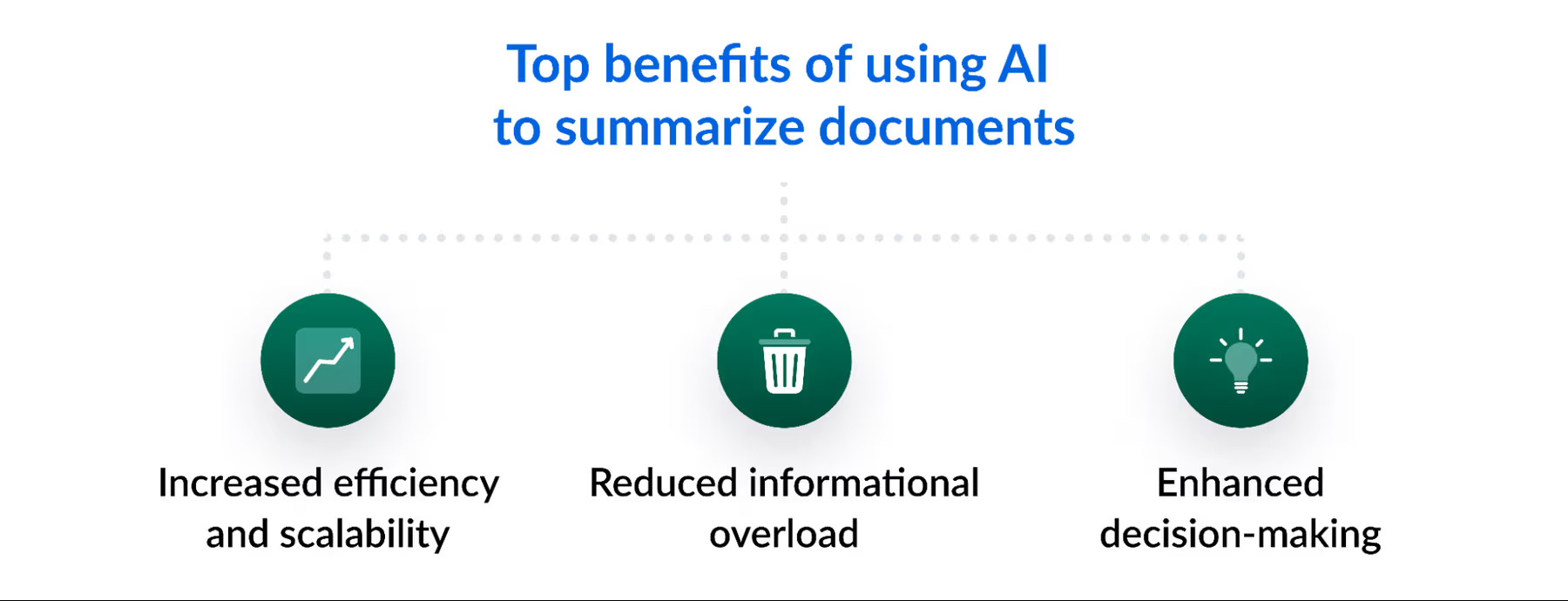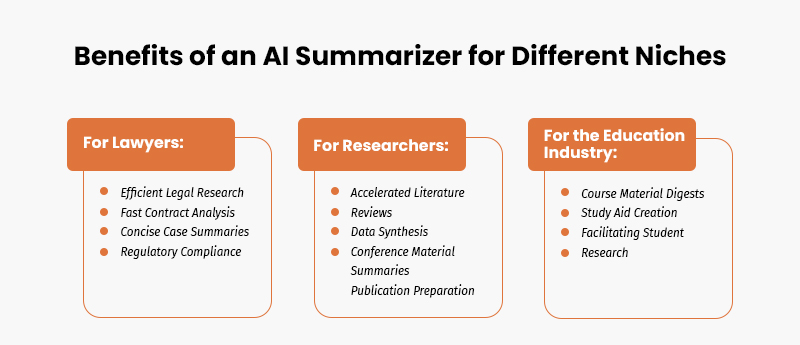AI Summarizer: Meaning and Working Explained (2025)
Table of Contents

“Too much to read, too little time.” Sound familiar? Between the ongoing emails, heavy reports, and meeting minutes that seem to last for hours, today’s office environment has become overburdened with information. And getting through all this information feels more like chasing a train rather than jumping on one. You are never quite catching up!
This is where AI summarizers come to the rescue; Artificial intelligence summarizers are your personal information assistant, keeping you focused on the most important content, cutting through the noise, and efficiently condensing long bodies of text into meaningful summary bites.
According to a study, it has been found that employees using the best summarizing tool experience a 66% increase in task productivity. And businesses that implement these AI tools can directly see the impact on their bottom line.
Additionally, by 2025, AI summarization will not just be a futuristic idea; it will have already changed the way businesses, students, researchers, and content creators understand information. From boardrooms to classrooms, these AI summarization tools help people regain time, enhance their decision-making skills, and enable them to keep pace with the fast-paced digital world.
But how can you create a custom AI summariser that works for your business? Well, that’s what our blog is about. We will uncover the benefits of implementing an AI summarizer, how it works, and provide quick tips to use it.
What is an AI Summarizer?
An AI summarizer is a piece of software developed with large language models (LLMs) that can take lengthy pieces of content, including an article, report, conversation, or book and refine it into a summary.
Think of an AI summarizer as an extremely smart friend who reads a long article and tells you what you need to know.
Older software used simple keywords to look for relevant content; newer AI summarizers use natural language processing (NLP) and machine learning to understand context, tone, and meaning. The goal? Identify the most relevant insights while retaining accuracy. There are two types of summarization methods:
- Extractive Summarization – Extracts the most important sentences and combines them.
- Abstractive Summarization – Rewrites the content in different words to explain it the same way a human would.
These methods can be used for all kinds of summaries, including news briefs, meeting summaries, and academic research.
Useful Benefits of a Summarizing Tool

*blog.box.com
There are several benefits of utilizing an AI summarizer to summarize the text. Some of the most useful benefits of a paragraph summarizer are as follows:
1. Quick Identification of Main Points or Ideas
Artificial Intelligence can summarize everything for us in seconds, and as a result, it can quickly summarize your key takeaways from long-form text. Generally, when you read a long article, research paper, or report, you have to spend time reading the entire piece to get the key points, and we know that takes time and is hard work.
AI summarizers take care of that for us by quickly scanning the text, identifying the key elements, and summarizing them for us. The time savings alone is substantial, allowing you to more easily identify the key points, while still reading the pieces and getting more of the key aspects covered.
2. Maintains Quality and Accuracy
The most common concern around summaries is original meaning and context. With AI Summarizers, that is simply not the case. AI summarizers are engineered to retain the ‘originality’ of the material while still providing a summary of that material.
The summary not only becomes shorter but also clearer and more accurate. AI finds a way to combine brevity with quality, something people can struggle with. AI simply performs this whole process without any complication and provides accurate results that show what is being summarized.
3. Time-Saving
In today’s fast-paced world, time is one of our most valuable resources. Manually reading and summarizing long documents requires patience and effort, which may not always be available for students, professionals, and academic researchers.
The amazing advantage of the best summarizing tool is that it produces summaries, whatever the length of the original document, in seconds! This efficiency gives you precious time to dig deeper, make a decision or complete another high-value task. To put it simply, you now have the ability to work smarter, not harder, with AI summarizers!
How AI Summarization Works
All the AI summarizers available on the internet are based on a summary principle. So, to understand working efficiently, we have to first understand the summary principles that are as follows:
1. Extractive Summarization
Extractive summarization is similar to picking out the most important sentences in a document. Consider an example where you are reading a lengthy research paper and underlining the lines that matter most; this is what an extractive AI summarizer does! The system analyzes the entire body of text in the document, evaluating the importance of sentences based on various factors, including word frequency, placement, and relationships to other sentences. It then selects sentences from the document based on their importance.
The final summary is a compilation of chosen sentences put together in a way that reflects the original content. Its strongest point is accuracy because it does not change any of the wording, so no message is altered.
2. Abstractive Summarization
The process of abstract AI summarizer is quite different. Instead of taking a sentence directly and shortening it while maintaining the same meaning, direct summarization involves rewording and creating new sentences that convey the same meaning, but in a comparatively concise and abbreviated format. Think of it like someone read everything in a document, and then they explained it back to you in their own words.
This process requires understanding the deeper meaning of a text and then generating a summary that is both concise and sounds natural. Summaries usually feel more engaging and more pleasant to read than extractive summaries. It is especially useful in situations and formats where clarity and a smooth read are important, such as news articles, reports, and presentations.
The only problem with this method is ensuring that the accuracy is 100%. To the extent that you are writing over the top of the summary, there is a potential to introduce errors or neglect small details. However, if done well, the abstracts produce a summary that is not only going to be shorter in length but is also more interesting to read.
4 Tips for Using AI Summarizer Tools

*matellio.com
Here are some best practices to make the most of AI summarizers.
1. Customize the Summary based on the audience
Depending on the audience, not all summaries need to include the same information. For example, a business leader may want a high-level summary in terms of key findings, while a student or researcher may want a more in-depth version that includes context. Be sure to customize the summary to your audience, using short and concise information for decision-makers, and more in-depth analysis for academic or professional purposes.
2. Provide Clear Instructions
The quality of a summary will greatly depend on the clarity of your instructions. Be clear about what you want to convey in your summary. Are you specifically interested in financial, research, commercial, or general takeaways? Clear instructions will also ensure the output will be relevant, insightful, and aligned with your objectives.
3. Balance Tools with Human Judgment
Human judgment is helpful when reviewing the final summary output from the best summarization tools. Doing so preserves accuracy, retains nuance, and ensures the summary meets your standards. Human judgment is equally important when an AI Summarizer outlines sensitive or complex topics where contextualization matters.
4. Use Multi-Format Summarization
Information isn’t just in plain text; it can also take the form of videos, presentations, or transcripts. You want summarization tools that can help you summarize all formats, ensuring you capture insights from any source. This budgeting method is especially effective when summarizing meetings, webinars, or training sessions, where valuable nuggets of information may go unnoticed.
The Bottom Line
In a nutshell, AI Summarizer tools have become a game-changer for students. They provide an efficient way of converting a massive amount of content into precise and clear insights without losing meaning.
The demand for such technologies is ever-increasing, and with this comes the demand to understand how they work and their applications. So for those wishing to experience how innovations such as this are transforming management and business practices, Jaro Education offers world-class online programs combining technology and management knowledge to equip you well for the future. Visit our website to explore our courses and online certification programmes.
Frequently Asked Questions
Who is best suited to benefit from summarization tools?
Students, researchers, corporate executives, educators, and developers of content and media will likely use summarization tools to save time and efficiently learn valuable information.
Are automated summaries always possible to get right?
Most of the time they are likely to preserve the main idea, however, it is better to involve a human review of more complicated topics.
When we talk about examples of extractive or abstractive summarization, What is the difference?
Extractive AI Summarizer summarizes work by pulling word for word sentences from the source material, whereas Abstractive summarizes the content in new language.
What types of things can I do to ensure I get better results from summarization tools?
Provide clear instructions, consider your audience, and rely on humans to check for quality.
Recent Blogs
It seems we can't find what you're looking for.










![AI Engineer Salary in India [For Beginners and Experienced] in 2025](https://jaro-website.s3.ap-south-1.amazonaws.com/2025/05/AI-Engineer-Salary-in-India-For-Beginners-and-Experienced-in-2025.webp)






